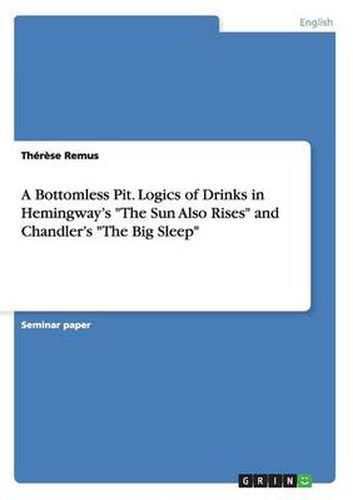Readings Newsletter
Become a Readings Member to make your shopping experience even easier.
Sign in or sign up for free!
You’re not far away from qualifying for FREE standard shipping within Australia
You’ve qualified for FREE standard shipping within Australia
The cart is loading…






Seminar paper from the year 2014 in the subject English Language and Literature Studies - Literature, grade: A/ 1,0, New York University (Department of English), course: Seminar: Transatlantic Modernism , language: English, abstract: Given that both authors, Hemingway and Chandler, represent a rather lean and reduced style, the extraordinary emphasis put on the recounts of drinking in both narratives is striking. This phenomenal contrast between the significant role of drink within the narrative and the sobriety of the narration on the level of style renders the depiction of scenes around drinking especially noteworthy. Much has been said about Hemingway being a dedicated and heavy drinker and thus literary criticism was often all too easily tempted to reduce the dominance of the topic of drinking in the novels to … either the unavoidable … aspect of the Hemingway hero …, or [to a] barely mediated reinscription of the author’s private drinking habits (Nicholls 2000 (b): 86). Another approach was taken by representatives of medical and sociological studies on the representation of alcoholism in mass media who understand Hemingway’s novel as a depiction of the expatriate scene in 1920s Paris and interpret the text as a promotion of drink as political attitude (cf. Room 1984: 543). These approaches, however, do not consider the functional employment of drink and respective rituals as fundamental elements of narrative structure apart from moral and medical connotations. They furthermore assume a highly simplified and homogenous quality of group dynamics on the level of the characters. This essay follows argues against a reading of Hemingways novel as using drink to establish a moral evaluative system. Arguing that both Hemingway and Chandler construe drink as a social and physical code drawing on a complex inventory of gestures and discursive patterns, the essay identifies moments of the narratives which show the constant encoding and decoding of drinking as a com
$9.00 standard shipping within Australia
FREE standard shipping within Australia for orders over $100.00
Express & International shipping calculated at checkout
Seminar paper from the year 2014 in the subject English Language and Literature Studies - Literature, grade: A/ 1,0, New York University (Department of English), course: Seminar: Transatlantic Modernism , language: English, abstract: Given that both authors, Hemingway and Chandler, represent a rather lean and reduced style, the extraordinary emphasis put on the recounts of drinking in both narratives is striking. This phenomenal contrast between the significant role of drink within the narrative and the sobriety of the narration on the level of style renders the depiction of scenes around drinking especially noteworthy. Much has been said about Hemingway being a dedicated and heavy drinker and thus literary criticism was often all too easily tempted to reduce the dominance of the topic of drinking in the novels to … either the unavoidable … aspect of the Hemingway hero …, or [to a] barely mediated reinscription of the author’s private drinking habits (Nicholls 2000 (b): 86). Another approach was taken by representatives of medical and sociological studies on the representation of alcoholism in mass media who understand Hemingway’s novel as a depiction of the expatriate scene in 1920s Paris and interpret the text as a promotion of drink as political attitude (cf. Room 1984: 543). These approaches, however, do not consider the functional employment of drink and respective rituals as fundamental elements of narrative structure apart from moral and medical connotations. They furthermore assume a highly simplified and homogenous quality of group dynamics on the level of the characters. This essay follows argues against a reading of Hemingways novel as using drink to establish a moral evaluative system. Arguing that both Hemingway and Chandler construe drink as a social and physical code drawing on a complex inventory of gestures and discursive patterns, the essay identifies moments of the narratives which show the constant encoding and decoding of drinking as a com